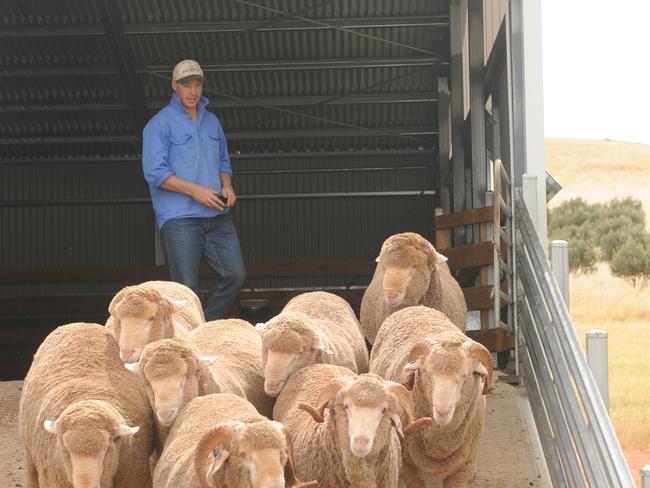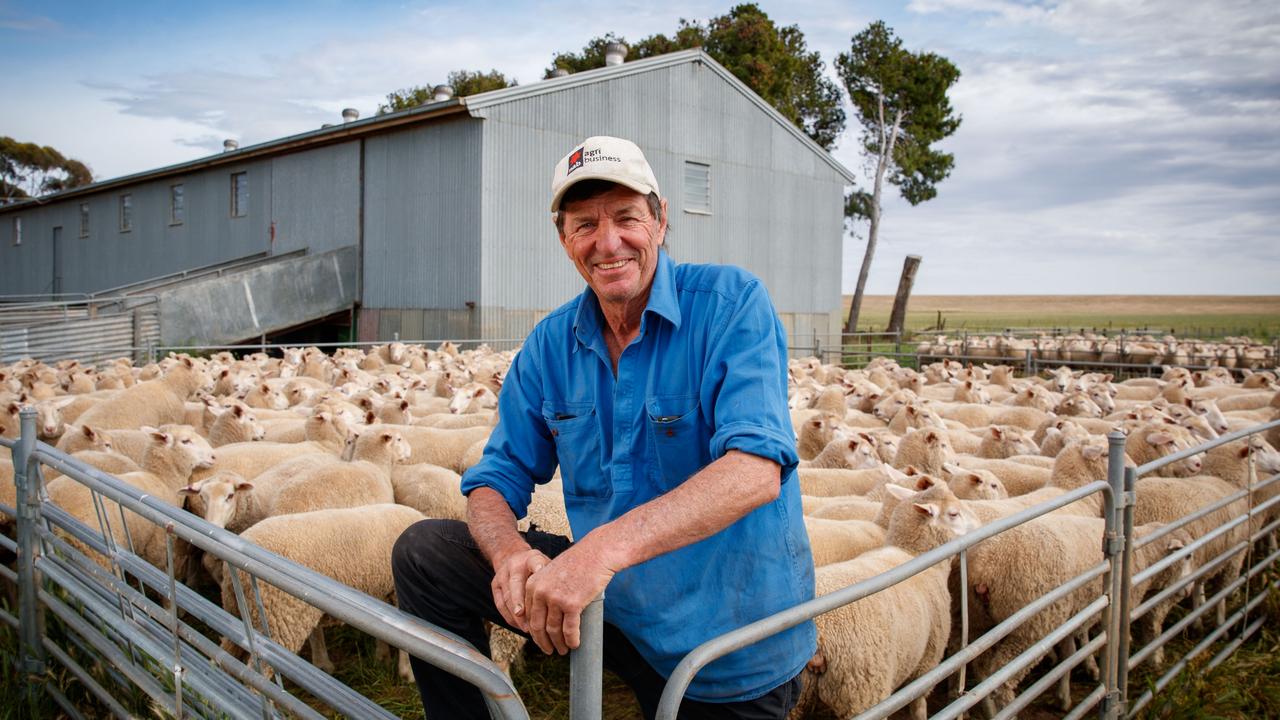Sheep production: Collinsville Merino stud gets new lease of life
GEORGE Millington, the new owner of the iconic Collinsville Merino stud, plans to honour its place in the industry, writes JAMES WAGSTAFF

IF ANY one word accurately encapsulates Collinsville — one of Australia’s legendary Merino sheep outfits — it is big.
It is in the big dusty paddocks of South Australia’s Mid North region that the big operation with the big reputation for producing big sheep with big wool cuts that attract big prices has evolved over its more than 120 turbulent years of existence.
It is here big dreams have been made, and equally as big wins and losses realised.
Registered as flock No.318 in 1895, Collinsville can almost be considered part of Australian farming folklore.
It sells 900 rams a year and is said to have influenced a third of the nation’s Merino sheep flock.
Who can forget the monstrous — some would say questionable — prices it achieved at the height of the wool boom in the late 1980s (culminating in a world record $450,000 for a three-quarter share in a Collinsville ram in 1988)? Or the role the stud played in the downfall of the once-proud State Bank of South Australia when it was placed in administration in 1991. More than a quarter of a century on, Collinsville is well and truly back on track thanks to a young, enthusiastic management team with their sights firmly on the future.
BACK DRAFT
AT THE helm is 41-year-old owner George Millington, who, despite hailing from Adelaide, knew the Collinsville story all too well growing up. “Everyone in South Australia did,” George says with a smirk.
George and wife Sophie (who grew up on a farm in the Mid North) are relatively new to farming, having moved from Adelaide, where they ran the APD Parcel Delivery Service, to Hallett in 2010 when they bought the historic 2040ha Cappeedee Station.
“My family had always had farms but I had never lived on a farm,” he said.
Four years later, they bought the 55,850ha Collinsville Station, northeast of Burra, its famous stud and sheep, from BRW rich listers Paddy and Helen Handbury, who had paid receivers $7 million for it in 1995.

The Millingtons became only the fourth owner of Collinsville in its history, but the third in the 20 years “since it went broke”.
“It was a fantastic opportunity but also a large responsibility,” George said.
“There is a lot of history and it’s one of the founding studs in Australia and influences so much of what goes on in the Merino industry, and has done for a very long time.”
OUTSIDER APPROACH
GEORGE said he aimed to run Collinsville on traditional lines — producing structurally correct sheep that could provide commercial clients with a 7kg fleece of 21-micron wool — but with a fresh take.

He has invested in a new ram shed and sales facility on Cappeedee, and added an extra 3440ha of land in recent months with the purchase of neighbouring properties Hillview and Kurcilo.
This brings the size of the Collinsville operation to 61,110ha: 5260ha of “inside country” — within the Goyder line boundary which separates productive agriculture land from marginal country — and 55,850ha of pastoral country at Collinsville Station itself.
George said the purchase of Hillview and Kurcilo gave them “more inside country to enable us to breed more ram lambs and sell more ram lambs”.
“Last year we sold out of rams, about 900 rams, and in the coming season we’re looking at selling more than 1000,” he said. “We want to try and grow the business and the new land acquisition is all part of that.”
Stud manager Tim Dalla, 35, who has worked at Collinsville under both the Handbury and Millington regimes, said annual rainfall varied greatly, from an average of 400mm at Cappeedee to 275mm at Collinsville itself.

It is a winter-dominant rainfall, with most falling between April-May and October. Tim admitted the second half of last year produced one of “the best seasons ever”.
“There was no spring (in 2015), a very tough summer, tough break, tough winter — it gets very cold here — and we didn’t get any growth until we had a lot of rain in August and September,” he said.
There are improved pastures, including ryegrass and clovers, on the arable country, with the hills only used for winter grazing, Tim said Collinsville Station comprised flat and hilly terrain with areas of saltbush, mallee scrub and bluebush.
Operating with a staff of five, Collinsville joins about 11,000 Merino ewes, 5000 of which are registered as part of the stud, along small cropping “for our own use” and beef enterprises.
RAM RAID
COLLINSVILLE aims to produce a “large-framed, structurally correct sheep that will survive and produce a high quality, heavy cutting medium-wool fleece”, Tim said, adding that it must be reasonably plain bodied, highly fertile and have good early growth.
Joining is for eight weeks in November and December for a May-June lambing. About 500 of the top stud ewes, aged two to five years, are artificially inseminated. Tim said there were also two embryo transfer programs a year — one in December and one in March — involving 10 donor ewes.
The commercial flock is joined at a rate of about 2.5 rams to 100 ewes, two rams to 100 for stud ewes and one to 100 for special stud ewes.
“With the single sire matings there’s a bit of risk involved, but we just try and eliminate that risk as we can down the pecking order,” Tim said.
Tim said Collinsville was not a closed flock, “but you’d say we’re a predominantly closed flock”.
“With our AI, we try to use one outside ram a year: (a) to try and improve, and (b) for benchmarking. Generally that ram is of a similar type to ours and quite often from a Collinsville daughter stud,” he said.
Last year they used semen from a ram from the East Mundulla stud in Western Australia, which in turn was sired by a Collinsville ram.
RATES NOTICE
LAMBING rates vary according to seasonal conditions, particularly on the station country.
Tim said last year was “one of the poorest years ever” with 60 per cent compared to the previous year’s 115 per cent. “That’s probably the two extremes … we’ve got an average of 85-90 per cent,” Tim said.
“The last 10 years it’s probably gone from one third poll to three quarters poll, and it’s definitely going to keep going that way”
Before last year’s spring break, Collinsville Station had received just 125mm of rain in 12 months.
Tim said while the ewes achieved a pregnancy rate of 85 per cent at scanning — “which we were quite happy with considering the seasonal conditions” — a lack of feed meant they had trouble rearing their lambs. Most paddocks on the station are about 2020ha in size and run between 300 and 500 ewes per mob.
The “inside country” works on an average lambing percentage of 100 per cent. In 2015, it achieved 121 per cent.
Lambs are marked, and mulesed, with pain relief, in July, “At this stage we still think that is our best option, especially at the station because you just never see them,” Tim said. “If they get flies, they die.”
Weaning takes place in late August. Tim does classing with the help of stud consultant Michael Elmes, with ram lambs classed in February and sale rams in August and October for AI ewes ahead of joining. Electronic ID of stud sheep was introduced about a decade ago.
Tim said the stud culled heavily with anything that failed to come up for standard on size shown the door. Rams are weighed and classed every three months.
SHEAR DELIGHT
STUD ewes are shorn at the start of November with the commercial flock following in February.
Everything gets micron tested and fleece weighed at shearing, with stud ewes cutting an average of 9kg of 21-micron wool and commercial ewes cutting 7kg.
With the “pretty tough season in the past 12 months” stud ewes cut 8kg of 19.8-20.3 micron wool at the most recent shearing. Wool (about 700 bales is produced annually) is sold through the Melbourne wool sales, with most sold straight after shearing.
Tim said about 20 rams entered the ram shed in November to minimise their exposure to grass seeds and dust ahead of the stud’s annual field day in March. Collinsville shows sheep at the Hay Merino Sheep Show and has displays at the Australian Sheep and Wool Show at Bendigo and the National Merino show at Dubbo, in NSW.
Another 50 10-month-old rams come into the shed in March that go on to be sold at the Adelaide multi-vendor ram sale in September or form the “front row” — the first 25 pens — of the stud’s on-property auction shortly after. Rams are aged 17 months at auction.
At last year’s production sale, 200 rams sold to a top price of $32,000 and averaged $2100. Collinsville also sold a ram for $33,000 in Adelaide. Private selection rams sell for between $600 and $800.
“We’ve got clients that took up to 140 rams this year,” Tim said. “Most take 20 to 50.”
POLL POSITION
TIM said about three-quarters of Collinsville rams were now polled.
“The last 10 years it’s probably gone from one third poll to three-quarters poll, and it’s definitely going to keep going that way,” Tim said.
The bulk of the clients are in South Australia, around Hay and Ivanhoe in the NSW Riverina, from Wilcannia in NSW stretching right up to Queensland” and “a couple” in Victoria.
“We are breeding a lot of the pastoral rams from stud ewes that run at the station, which I think helps with their survivability when we sell them,” Tim said.
The stud does not incorporate Australian Sheep Breeding Values into its program but “we do use a lot of figures internally”.
All auction rams have current micron and bodyweights displayed. “We do a lot of body weighing because we’re big on growth rates,” Tim said.
George predicts a bright outlook for Collinsville, with the recent improved wool prices welcome by commercial growers.
“Wool seemed to have had a bit of an upsurge,” he said.
“The stockpile has gone. We’re probably into a more true demand-supply (system) where prices currently are, so we’ve got clients getting $2000 a bale. Where 10 years ago, they were getting $700 a bale.
“We’re in a pretty good spot.”


